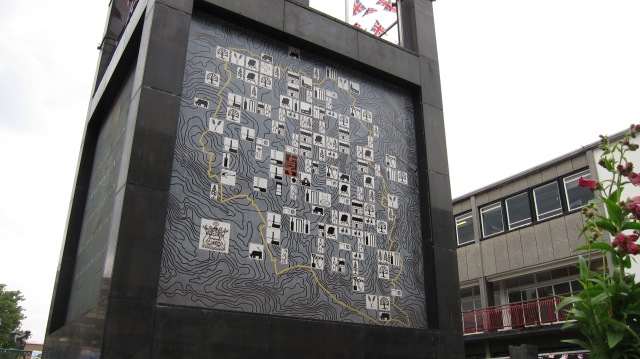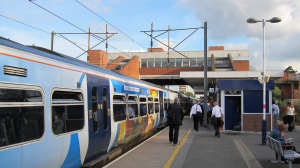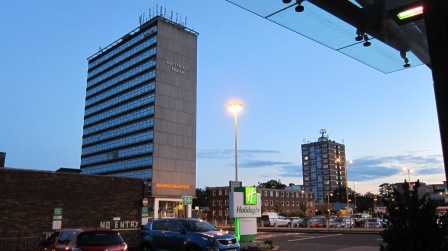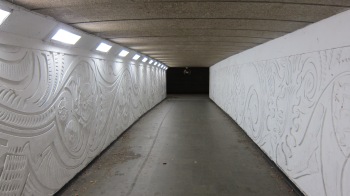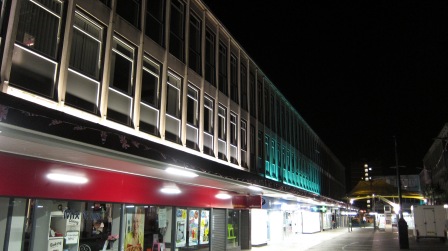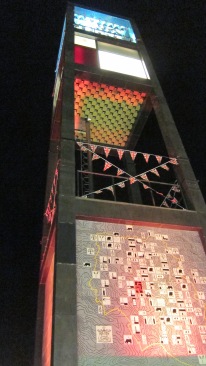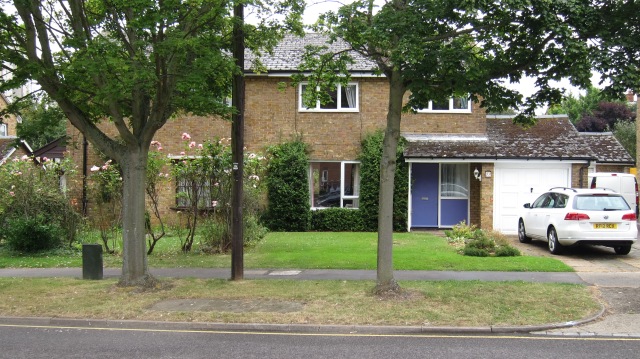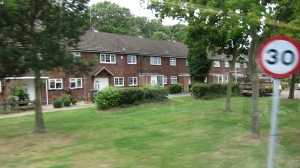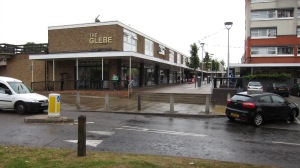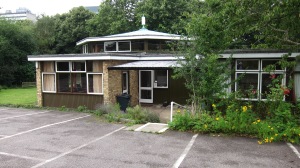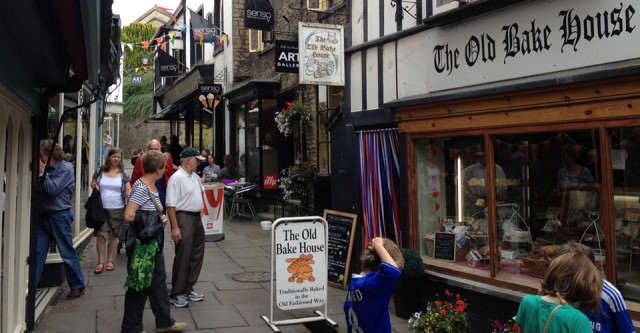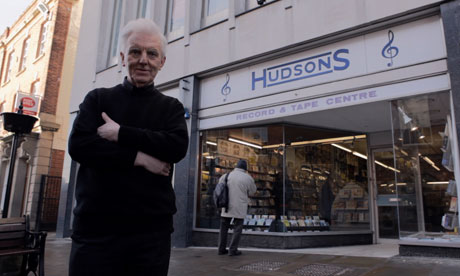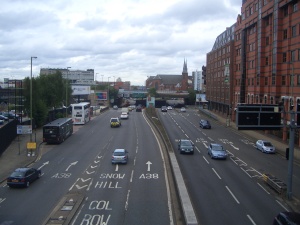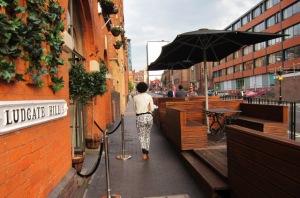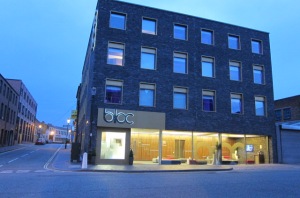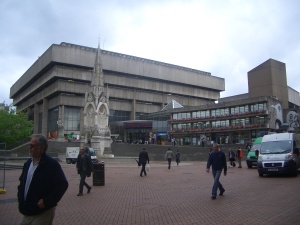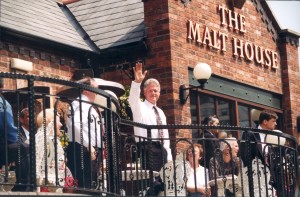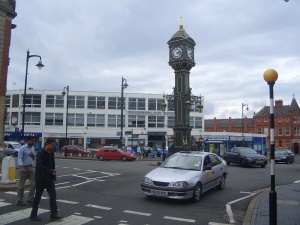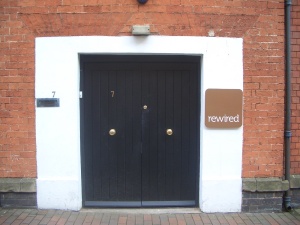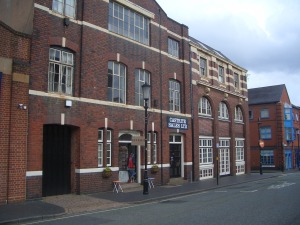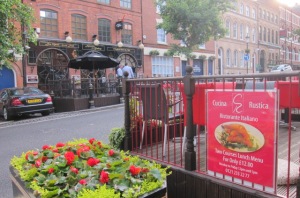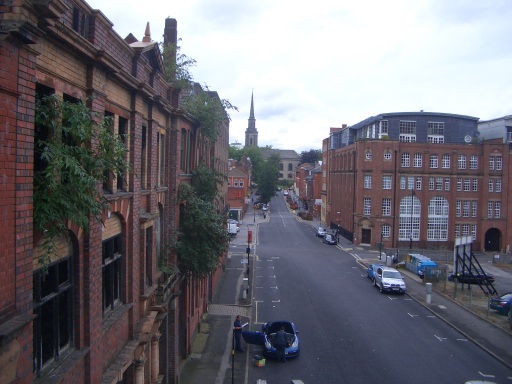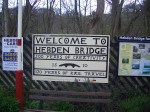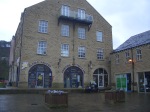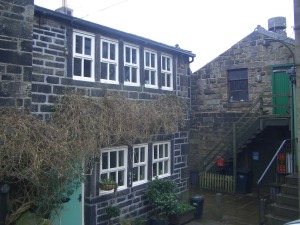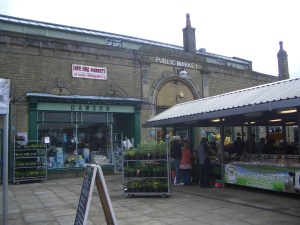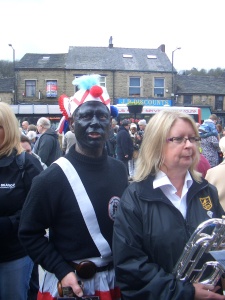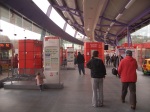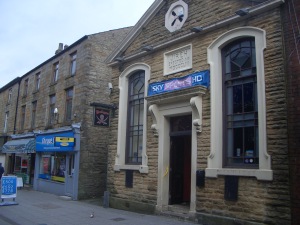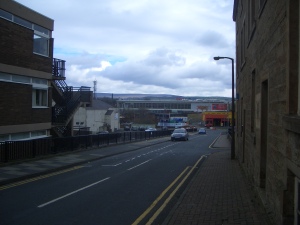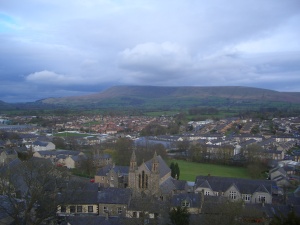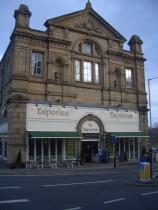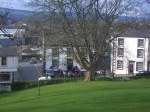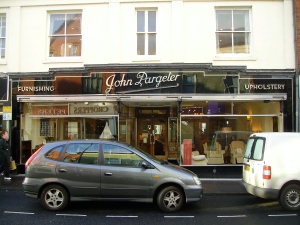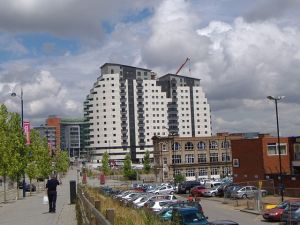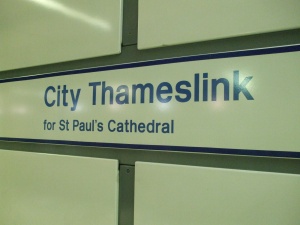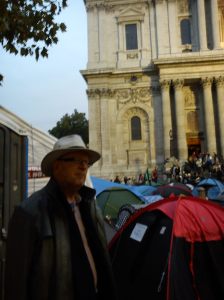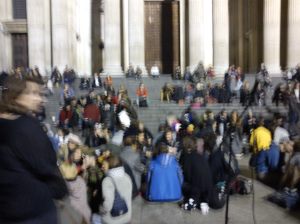The prospect of an expedition to Stevenage stimulated great excitement in the Urban Repairs Club. This Hertfordshire town, population 84,000, is either maligned or disregarded by most normal civilians, but among a select corps of town planners and urbanists, it is a legend: Britain’s first post-second world war New Town (with a capital “N” and a capital “T”), so designated by the Labour Government’s Ministry of Town & Country Planning in 1947 – the first of the eight new towns conceived by the 1943 Abercrombie Plan to accommodate London’s growth and to reduce overcrowding in its slum districts.
For 1940s town planners, this was their big chance: the putting into practice of the concepts they had been advocating for decades. Stevenage was not to be a mere peripheral overspill estate or banlieue: it was to be an entire self-contained town, providing the full suite of employment opportunities, social and civic facilities and amenities, as well as modern housing in a healthy environment – all actively planned to avoid the evils of the unplanned city.
For town planners now (especially those of the baby boom generation), the question of how the town is getting on at 65 years old is quite an emotional one. How well is it living up to the ideals of its wartime generation parents? What lessons and wisdom has it acquired to pass on to the next generation?
Also, as the Club’s first trip to the great soft South East of England, it promised our first engagement with the big urban planning issues of the South today. In particular, the chance to consider the contrast between 1947 and today’s response to the same problem: how to decently accommodate a fast-growing population.
Therefore a strong Club turnout was expected. However, the usual backsliding soon kicked in and the numbers diminished down to three.
Great Northern
For two of the three, the expedition began at London’s splendid new £250m Kings Cross station (the third arrived by epic trans-Home Counties coach journey, but that’s another story).
Kings Cross has rightly been celebrated as both a superb architectural restoration and an excellent demonstration of high-tech architectural capability at its best. In the year of the London Olympics it didn’t get that much hype, but is probably the best single architectural legacy of 2012.
It sits at the heart of the emerging Kings Cross railway lands development, the centrepiece of which is the excellent conversion of the old goods station into the new home of Central St Martins Art College. Now is the best time to visit the new Kings Cross, with the good renovation stuff completed and open, whilst the dross of the massively overdeveloped newbuild, which will both pay for it all and spoil it, is yet to come.
This genuinely exciting new piece of central London is significant to the Stevenage question, because in the evening rush hour up to 8 trains leave Kings Cross for Stevenage, the fastest of which takes just 20 minutes. Although London commuting had no part in the original conception of Stevenage New Town, it seems likely to be a key factor in its 21st century renaissance.
We joined the returning commuters on the Great Northern train; their adventures for the day drawing to a close, ours about to begin.
Arrival – Stevenage station
We arrived at around 6.30pm on a fine August evening. As the commuters strode off home, we lingered a little longer to get our bearings, alongside a small gang of football fans raucously singing out their allegiance to Stevenage Town FC, who were kicking off their season that evening.
Stevenage station is a purely functional building, very much of its era of British public sector architecture, when the bare concrete of brutalism was being eschewed for red brick cladding, but its forms were still being followed – albeit in a low cost way. An original plaque in the ticketing hall records its opening by Shirley Williams, MP for Stevenage, in October 1973.
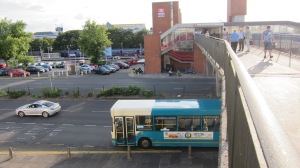 We walked out onto the elevated footbridge which links the station to the town centre, crossing the railway lines and the busy dual carriageway (A602 Lytton Way), and passing through the middle of the adjacent 1975 Stevenage Arts & Leisure Centre en route.
We walked out onto the elevated footbridge which links the station to the town centre, crossing the railway lines and the busy dual carriageway (A602 Lytton Way), and passing through the middle of the adjacent 1975 Stevenage Arts & Leisure Centre en route.
The opening of the new station and the arts & leisure centre marked a coming of age for the New Town, and was a matter for considerable civic pride. The old station was half a mile to the north, and served what is now known as Stevenage Old Town. Famously, when the Minister of Planning Lewis Silkin came up to unveil the New Town plans, its station signs were replaced by protesting residents to read “Silkingrad”. 26 years later, the New Town centre finally got its own station. Now, a major redevelopment of the station and its environs remains awaited.
The trajectory of the history of Stevenage New Town so far can be conjured up from the view from the footbridge.
The view north, down the railway line, towards the site of the old station, represents the post-war pioneer years of the new town. As well as remembering this as a heroic age of the “spirit of 45”, the enduring dislike of conservative Hertfordshire for this socialist incubus must also be understood.
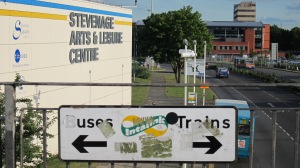 The view east, to the arts & leisure centre and the town centre’s office blocks and shopping precinct, represents the heyday of the social democratic New Town project.
The view east, to the arts & leisure centre and the town centre’s office blocks and shopping precinct, represents the heyday of the social democratic New Town project.
The view west, to the dire sheds of Stevenage Leisure Park (containing Cineworld, Hollywood Bowling, Nandos, McDonalds), represents the ditching of social democracy in the 1980s and its replacement by privatisation, hyper-consumerism and car-dependent development.
Today’s mores are represented by what you can’t see. An urban extension onto greenfield land west of the A1(M) (“West Stevenage”), which sparked a bitter 10 year-long planning fight, scrapped following the abolition of regional plans, and not a single new home built. A major privately-financed redevelopment of Stevenage town centre, put on ice after the 2007 crash, also now scrapped altogether with apparently nothing achieved.
The footbridge is in itself a period piece. It is a good and useful idea, allowing pedestrians to move between the station and town centre without having to cross a busy road or negotiate steps. Its rather spartan, low budget functionality is leavened by a dash of socialist design flair, with exciting glimpses down into the leisure centre sports hall. It’s free to use, and nobody is trying to sell you anything as you stroll along it. Nevertheless, most people would call it a failure. It looks and feels rather bleak, whilst some of the windows allowing free spectating of the activities in the leisure centre have been whitewashed out – to prevent perverts from loitering, we were later told.
The Town Centre Precinct
 We pressed on into the town centre, past the old Locarno ballroom (now Mecca bingo) and the bus station. Whilst loitering (and giving every impression of being, if not perverts, then certainly strangers), we met local man Michael Jackson, who very kindly joined our party impromptu to become our genial and expert native guide.
We pressed on into the town centre, past the old Locarno ballroom (now Mecca bingo) and the bus station. Whilst loitering (and giving every impression of being, if not perverts, then certainly strangers), we met local man Michael Jackson, who very kindly joined our party impromptu to become our genial and expert native guide.
The town centre is a classic post-war modernist design, with a “precinct” of fully pedestrian streets and town square with no vehicle access at all, all servicing and car parking being to the rear. The buildings are pure modernist in style, concrete-framed with big single-glazed windows, shop fronts at the ground floor level, 2 storeys of offices or flats above.
The centrepiece is the central town square, with fountains and clocktower, with stone plaque proudly proclaiming its opening by the Queen in 1959: perhaps the most photographed and remembered day in the history of the town.
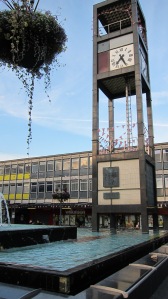 The precinct is so familiar in style, and so dated-looking now, it is amazing to imagine how utterly new and futuristic it must have seemed when originally built. The design completely reflects the “spirit of 45” ideal of a completely fresh start, leaving behind the legacy of exploitation, poverty, overcrowding, pollution, ill health, economic depression and war for a new peaceful future of shared endeavour and social welfare.
The precinct is so familiar in style, and so dated-looking now, it is amazing to imagine how utterly new and futuristic it must have seemed when originally built. The design completely reflects the “spirit of 45” ideal of a completely fresh start, leaving behind the legacy of exploitation, poverty, overcrowding, pollution, ill health, economic depression and war for a new peaceful future of shared endeavour and social welfare.
Although Michael Jackson and select other Stevenagers keep the dream – or, more accurately, the memory of the post-war dream – alive, it is important not to underestimate how utterly rejected and forgotten it feels on the ground. The town centre looks profoundly run down and unloved. The neglect of serious maintenance of the buildings – possibly the result of blight from the long expected redevelopment – gives it a very shoddy look.
At a guess, most Stevenagers and probably 99 out of 100 outsiders would say they hate it. Classic modernist architecture remains resolutely unpopular with the people. Most people would likely pigeonhole it as a “60s concrete jungle”, despite it being designed in the 40s and built in the 50s. For Hertfordshire’s aspirational classes, Stevenage precinct is chav-ville, everything you’ve left behind and want nothing more to do with.
But the Urban Repairs Club’s Stevenage enthusiast faction has unusual tastes. Their mission was to persuade the rest of the club that this environment had real qualities and virtues that were being misunderstood and undervalued.
One might have expected a concrete pedestrian shopping precinct to feel unsafe and threatening in the evening, but in fact the mood on this pleasant August evening was rather mellow and relaxing, we were told. The fountain played and the square’s mature trees were adding greenery and softening the geometry in exactly the way the original designers intended. People were around, with no anti-social behaviour in evidence. The lack of vehicular traffic – supposedly a design problem after close of business in a pedestrianised shopping area – was a real and rare plus.
The architectural ensemble is a perfect period piece: it is as iconic of its era as St Pancras station (also left to rack and ruin, and nearly demolished at the nadir of the popularity of its architectural style), is of its own. Its very British modernism is in fact very humane.
 It is nonsense to say that the precinct’s buildings are incapable of being restored (the enthusiast faction continued), they are being left to rot because their owners want rid of them. The biggest culprits for the pervasive air of shoddiness are the faded sticking plasters of sporadic projects to spruce it up dating from the nineties and noughties – spruce ups appearing to consist solely of another round of pointless signage and other clutter, of a variety of styles but all failing to respect the original modernist design.
It is nonsense to say that the precinct’s buildings are incapable of being restored (the enthusiast faction continued), they are being left to rot because their owners want rid of them. The biggest culprits for the pervasive air of shoddiness are the faded sticking plasters of sporadic projects to spruce it up dating from the nineties and noughties – spruce ups appearing to consist solely of another round of pointless signage and other clutter, of a variety of styles but all failing to respect the original modernist design.
The worst thing Stevenage could do is to reject and demolish that which makes it special, and replace it with some dreadful privately-financed commercial development that will be infinitely worse. Instead, it should be declared an Area of Outstanding British Urbanism, cherished, protected, and lovingly restored.
Were we buying this outrageous sales pitch? Michael Jackson certainly wasn’t immediately convinced.
We checked in to the Holiday Inn and then went to the town centre’s JD Wetherspoon in search of dinner, to discuss matters further and hear more about the history of Stevenage.
Stevenage – a family’s industrial history
Michael Jackson was born and bred in Stevenage, in the Chells neighbourhood. His parents had come up from Hackney in 1962, having been offered a house by the Stevenage New Town Development Corporation. They hadn’t been meant to get a house in the slightly more upmarket Chells area, as the rents were higher than his manual worker parents were considered to be able to afford. But his Mum had jumped off the bus that had been laid on from Hackney for migrants and bagged one anyway. As a result, the next door neighbours were the school headmaster, the local doctor, and the like.
Stevenage in the 1970s was a solid working class community – or in fact, a series of working class neighbourhood communities. All Stevenagers were very conscious of where their neighbourhood stood in the pecking order from respectable to disreputable. Some of the incomers had brought North East London ways with them, and drugs, gangsters and other dodgy behaviour were all well known in the town. But the town was fully functioning in pretty much the way it had been planned to do – happy, healthy and increasingly prosperous.
As a post-war baby, Stevenage was also a product of the cold war era and its military-industrial complex. Among its biggest employers were De Havilland and English Electric (steered to Stevenage by Planning Ministry mandarins from their first choice of Luton), which later became Hawker Siddeley and the British Aircraft Corporation respectively, then in the 1970s merged to become British Aerospace. Among Stevenage’s products were the Thunderbird guided missile in the 1950s, and later in the 1970s, the Rapier guided missile. It was also part of the original doomed independent British space programme, and Stevenage still makes high tech systems used on spacecraft, including the Mars rover.
It seems the whole bewildering industrial history of post war Britain can be told through Stevenage’s story. Other big 1960s/70s employers included Bowaters paper, Avery weights, Kodak instamatic cameras. ESA, makers of wooden school desks, had been a big Stevenage employer, but government regional policy had enticed them away to Glasgow, to create jobs there. Government jobs were important, with the Inland Revenue and the Land Registry having offices in the town, providing sought-after steady jobs. In the 1980s, the big manufacturing employers left vacant sites in the industrial zone to the west of the railway line, and one of these was redeveloped into the Stevenage Leisure Park.
Michael left Bedwell School, Stevenage, with four Grade 1 CSEs and, with his sights set on the aerospace industry, went to study applied metalwork (milling and turning), with an evening class in O-level physics. His application to British Aerospace was blacklisted because his Dad had been a key player in a strike at the factory. Instead he joined the RAF and spent seven years as a technician on helicopters in St Athan, Wales – happy years with an active social life, including in the Theatre Club. His post-RAF career had been in retail, with notches on his belt including Allders in Lincoln, Rumbelows in Spalding, Tesco in Milton Keynes and Flitwick. He had completed a Masters degree in retailing studies, his masters’ dissertation being on the saturation level for supermarket floorspace in Stevenage. He had also recently done factory work, including fairly brutal spells in the Fens overseeing fruit and vegetable packing for the supermarkets by Eastern European immigrants.
Stevenage remains a working working-class town, and has not experienced anything like the trauma of mass unemployment like its new town contemporaries in the North, such as Skelmersdale. If you can travel, there are jobs out there in the buoyant economies of Hertfordshire and London. However, high tempo employers like suppliers to Tesco have little to offer skilled and willing workers such as Michael Jackson as they hit their late 40s.
Although Stevenage through and through, Michael’s own perspective was that Stevenage was pretty much finished as a suitable town for him and his now ageing parents, and was moving with them to hopefully greener pastures in Bramley, Hants.
As Michael expounded in JD Wetherspoons on Australian economist Steve Keen’s plan for getting the economy out of depression, it felt tremendously poignant that the British economy could find no role for a man with a far keener grasp of its realities, and better ideas for its improvement, than the Chancellor of the Exchequer himself.
We left (actually, were ejected from) JD Wetherspoons and then went on a late night roam around the town centre and the 24 hour Tesco megastore, having both places pretty much to ourselves, before retiring.
Stevenage by night – a gallery
Day 2: the residential areas
The plan for Day 2 was a simple one: to inspect the residential neighbourhoods of Stevenage of differing vintages – ideally one each from the 50s, 60s, 70s, 80s, 90s and 00s, and to see what we felt each one could teach us. Then, to return to the town centre to visit the Stevenage Museum before it closed. However, as we had done no research, and had no information other than an OS map, the execution was rather more hit and miss. In the end we sampled Chells (1960s), The Poplars (1980s/90s) and Bedwell (1950s).
The day started off with subterfuge. The doveish faction within the club felt it was important to see Old Stevenage, in order to get context, whereas the hardline faction deemed the place anathema, and out of bounds. The doveish faction therefore crept off to Old Stevenage under cover of going off to get breakfast. The hardline faction had the camera, and therefore the next section is unillustrated.
Old Stevenage
Old Stevenage is a short walk from the town centre, across a footbridge over the fearsome-looking A1155 Fairlands Way, but is – in the cliché – a different world. We had only been in Stevenage for 15 hours, but the sight of the old red brickwork of a Victorian villa was a welcome one.
Old Stevenage sits astride the historic old Great North Road and has the classic wide street flanked by coaching inns of the turnpike road era. It no longer carries heavy traffic, that role being covered by the nearby A1(M) which forms the western by-pass and boundary of the town. It is therefore quite pleasant, with a range of independent shops. Some of the coaching inns have been turned into branded upmarket eateries, in the Home Counties style. Old Stevenage is not posh (it is, after all, in Stevenage), but it passes as “nice”. It’s Daily Mail rather than Daily Star, but it’s not Daily Telegraph.
We breakfasted at TJ’s Café, which had taken advantage of the available street width to provide outdoor seating. Breakfast was excellent and good value; served efficiently and without fuss. We reflected over a cigar. This was an 18th and 19th century built environment proving far more popular in the 21st century than the 20th century one. This was the Home Counties proper, with a place for everyone, and everyone in their place. This was Churchill’s sturdy carthorse of English free enterprise, giving the people what they actually want (that may have been the cigar). We slunk back to New Stevenage in disgrace.
Chells
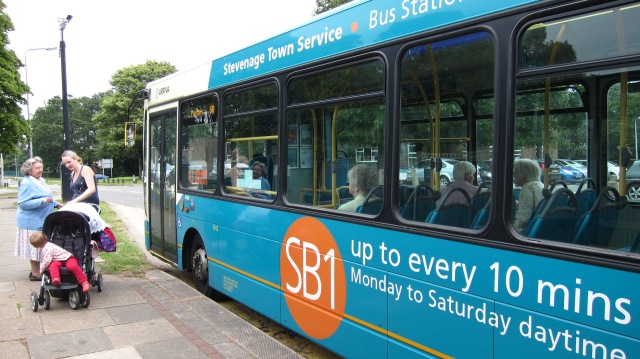 We headed for the bus station and took route SB1 (short for Stevenage Super Bus 1, a 1970 experiment with “turn up and go” frequency services) towards the residential slopes of East Stevenage.
We headed for the bus station and took route SB1 (short for Stevenage Super Bus 1, a 1970 experiment with “turn up and go” frequency services) towards the residential slopes of East Stevenage.
The bus set off up the verdant parkway road of Six Hills Way, past the oldest (1950s) neighbourhood of Bedwell and across the aptly-named Fairlands Valley Park, with impressive views south. The generous verges of the road contain a continuous segregated cycle path and footpath, each enjoying their own underpasses of roundabout junctions.
These rolling hills were selected for the residential area of the new town because they were a prime site, with clean air and uplifting views – not (as would happen today) because they were the least valued, worst available landscape. In this spirit, it resembles Canberra more than it resembles the Thames Gateway or Didcot.
We turned into Chells, developed in the early 1960s, and alighted at The Glebe neighbourhood centre. Chells mostly contains two-storey family houses, some terraced, some semi-detached, with gardens at front and back. They were built and let by the New Town Development Corporation. The vast majority of the houses were sold off to their tenants in the 1980s under the Thatcher Government’s right to buy legislation.
 On some houses little reminders of the New Town Development Corporation remain, such as surviving doors painted in its eggshell blue colours and numbered in its distinctive font. There’s nothing particularly special about Chells – in many ways it’s an absolutely bog standard post-war suburb. However, its era perhaps marked the historical high point in the amount of living space (mostly outdoor space, the houses are quite small) offered in new developments in the South East to people on an ordinary worker’s wage. Every decade since has seen a deterioration.
On some houses little reminders of the New Town Development Corporation remain, such as surviving doors painted in its eggshell blue colours and numbered in its distinctive font. There’s nothing particularly special about Chells – in many ways it’s an absolutely bog standard post-war suburb. However, its era perhaps marked the historical high point in the amount of living space (mostly outdoor space, the houses are quite small) offered in new developments in the South East to people on an ordinary worker’s wage. Every decade since has seen a deterioration.
The neighbourhood centre at The Glebe contains a mini-shopping precinct with flats above, a health centre and a pub. The shops include an ironmonger, a pharmacy, a newsagent, a cycle shop, a café, a charity shop, a chip shop, a Chinese takeaway, and a new Tesco Metro. It was the very model of a thriving suburban shopping parade – quite rare these days – and, above all, the public space was in an exemplary state of repair. We then noticed a plaque: it had been done up with a government grant and reopened only one month earlier.
It was good to see a walk-to suburban parade of independent shops working well, and getting the right backing from its public, and its council. Perhaps there’s even a place for Tesco Metro in that, on the right terms.
The Poplars
We reboarded the SB1 bus and headed for the Poplars area, developed in the 1980s (we think). It was built by private developers in a quite different era, and a quite different place has resulted. Here we see an example of the beginning of the “town cramming” of new suburbs, so characteristic of the past three decades.
Chells has a nice mix of private space and public space, with its generous verges – recognisably on the classic English garden city format (as delivered by a post-war quango). At Poplars, we see private developers simply selling a private space for a house with a private garden and a private parking space – a defensible postage stamp.
Unlike Chells, where the houses face the distributor roads (though set back from them behind verges, trees and gardens), in Poplars the housing is in culs-de-sac which turn their back on the road. The view from the bus is of a row of back fences. The layout is geared for car-dependency – the expectation that every trip, even short ones, will be made by car. The Poplars neighbourhood centre has a standard out of town Sainsburys with a large surface car park.
 Some classic 1980s/90s post-modern design touches amused us. The supermarket is brick-clad, with a tiled roof and fake gable ends – a very characteristic mock vernacular, reacting to the excesses of brutalism. Whilst the car park gets prime access to the supermarket’s front door, the SB1 bus is directed to the tradesmen’s entrance at the rear, where it has to turn round in a confined space by the loading bay. The bus passenger is absolutely the second-class citizen.
Some classic 1980s/90s post-modern design touches amused us. The supermarket is brick-clad, with a tiled roof and fake gable ends – a very characteristic mock vernacular, reacting to the excesses of brutalism. Whilst the car park gets prime access to the supermarket’s front door, the SB1 bus is directed to the tradesmen’s entrance at the rear, where it has to turn round in a confined space by the loading bay. The bus passenger is absolutely the second-class citizen.
 The health centre and scout hut are built in what could be called planning gain agreement mock-rustic, around a cobbled public courtyard. The space looked little used. We lunched at Poplars Fish Bar and caught the SB1 back towards town, alighting at Bedwell.
The health centre and scout hut are built in what could be called planning gain agreement mock-rustic, around a cobbled public courtyard. The space looked little used. We lunched at Poplars Fish Bar and caught the SB1 back towards town, alighting at Bedwell.
Bedwell
Bedwell, built out in the 50s, is different again. It feels unambiguously like a council estate. It’s a bit run down and needs maintenance, but, with its mature trees and lawns, it fundamentally looks rather good. At Abbots Grove, the houses (each with their own private front and back garden), are built around a communal green space with trees. Great for kids, who can just run straight out of the front gate and play, with no risk from traffic whatsoever.
On a summer afternoon, it felt like Hobbiton, with a few added devil dogs and dodgy geezers. There’s clearly both a fear and a reality of antisocial neighbours in a place like this – but on our flying visit, it felt like a successfully functioning place to live.
The most pleasing building we saw in Bedwell was the Friends Meeting House on the slope back down to the town centre. Humane architecture exemplified – and another treasure trove for our collection of classic lettering fonts.
The dreadful brutalist 1960s telephone exchange building was in the running for the worst place we saw, but it was outdone by Trefoil Lodge, a block of nineties or noughties in-fill flats at the corner of Cuttys Lane and Homestead Moat.
Built closer to the street than its neighbours, but with no front doors opening on to it, it’s a very familiar-looking cheap and nasty effort. There are no back or front gardens for older hobbits to tend, or for young hobbits to play in; instead every square inch of the rear courtyard is given over to car parking, defended by a rather absurd barrier. Trefoil Lodge feels like a mini-epitome of the social bankruptcy of today’s housebuilding and placemaking model compared to that of the New Town Development Corporation. However, supposedly it is “sought after” – its selling point presumably being that, by having no relationship with the public space at all, it can pretend it’s not in Bedwell.
Stevenage Museum and Market Hall
We returned to the town centre and dropped in on the excellent Stevenage Museum, in the crypt of the remarkable Stevenage Parish Church (1956-60), “the largest post-war parish church in England”. The museum has good, clear displays explaining the history of the new town. The 1947 cartoon “Charley New Town”, put out to advertise the new town to potential migrants, is a particular gem.
We then returned to the town centre precinct. We put one of our number on the bus to Hatfield and went to visit the market hall, another public facility delivered straightforwardly and well by Stevenage Borough Council. It has a good range of excellent and knowledgeable traders and is a great advert for this rather unfashionable retail format, which may in fact now be on the rise – it certainly seems to have more life in it than the more conventional retail offerings of the precinct. Afternoon tea was taken at Snack Shack in the market hall.
A final review of shop units for rent in the precinct, and we retired to the Holiday Inn to take stock and consider the Urban Repairs Club’s verdict on Stevenage.
Conclusions
[to follow]

